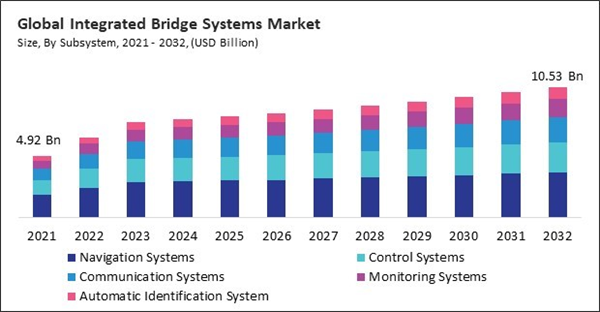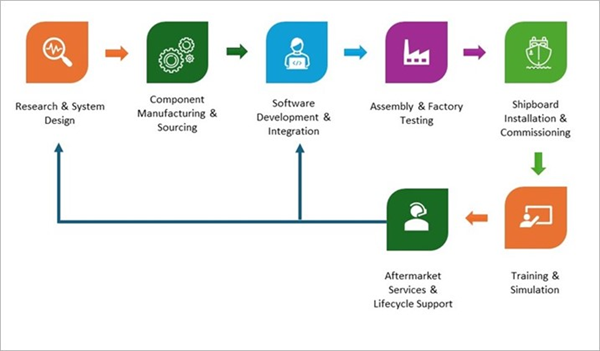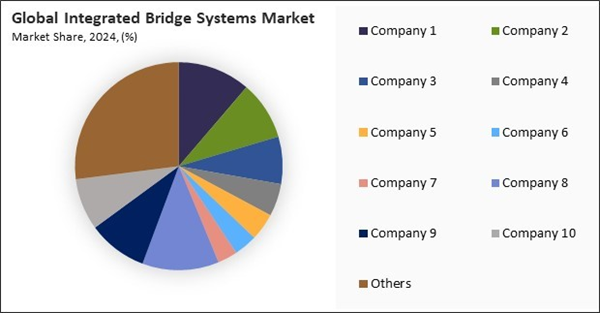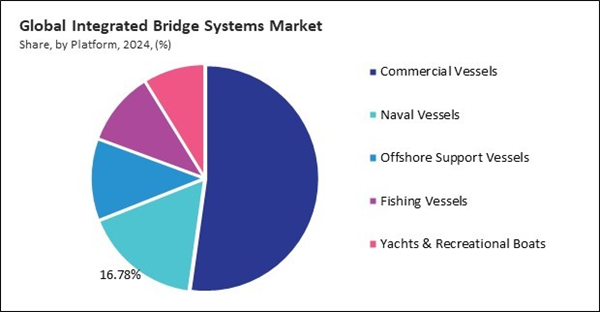Navigation systems are the most important part of the Integrated Bridge Systems (IBS) design. They provide real-time information on the vessel's position, direction, and situation that helps it operate safely and efficiently. Navigation is an important subsystem that brings together parts like radar, Electronic Chart Display and Information Systems (ECDIS), Global Navigation Satellite Systems (GNSS/GPS), gyrocompasses, speed logs, autopilot, and echo sounders into a single interface.
Driving and Restraining Factors
Drivers
- Rising Global Maritime Trade And Seaborne Transportation
- Increasing Focus On Maritime Safety And Collision Avoidance
- Integration Of Digitalization, AI, And Autonomous Navigation
- Naval And Defense Modernization Programs
Restraints
- High Initial Capital Investment And Maintenance Costs
- Integration Complexity And Interoperability Challenges
- Skills Gap And Resistance To Technological Change
Opportunities
- Expansion Of Smart Ports And Maritime Digitalization Ecosystems
- Surge In Demand For Autonomous And Remotely Operated Vessels
- Regulatory Push For Environmental Compliance And Fuel Efficiency
Challenges
- Standardization And Compatibility Across Multiple Platforms
- Cybersecurity Risks In A Digitally Connected Maritime Environment
- Limited Training Infrastructure And Operator Readiness
Market Growth Factors
Rising Global Maritime Trade And Seaborne Transportation
The steady rise in global marine traffic has been one of the biggest reasons why the need for Integrated Bridge Systems (IBS) has grown. The maritime sector is the most important part of worldwide trade. Almost 80% of the world's goods trade by volume and more than 70% by value goes by sea. The amount of goods moved across continents has grown a lot as globalization has gotten stronger and international trade has become more complicated. This has directly led to a need for ships that are safer, smarter, and more efficient. IBS plays a key part in this. As a result, the steady rise in global maritime trade and the requirement for vessels to operate in a way that is technologically sophisticated, efficient, and compliant are major factors driving the use of Integrated Bridge Systems.Increasing Focus On Maritime Safety And Collision Avoidance
Furthermore, as shipping channels throughout the world get busier, safety at sea has become a top priority for shipowners, naval architects, and regulatory organizations. Accidents at sea, such ship accidents, grounding, and oil spills, may have terrible effects on the economy and the environment. Integrated Bridge Systems (IBS) greatly reduce these dangers by bringing together several important navigation features into one easy-to-use interface. In conclusion, the effort throughout the industry to make shipping safer and lower the chance of accidents and collisions at sea is a strong factor behind the use and improvement of Integrated Bridge Systems.Market Restraining Factors
High Initial Capital Investment And Maintenance Costs
One of the biggest reasons how Integrated Bridge Systems (IBS) aren't used more widely is that they take a lot of money to buy, install, and keep up. IBS has a lot of benefits for safety and efficiency, but these benefits come at a cost that not all ship operators can pay, especially those that work in emerging nations or have small fleets. Depending on the kind, size, and role of the vessel, a contemporary IBS arrangement might cost millions of dollars. since of this, the Integrated Bridge Systems market can't grow very quickly since it needs a lot of money up front and has continuous costs for operations and training. This is especially true for stakeholders who are sensitive to costs.Value Chain Analysis
The value chain of the Integrated Bridge Systems (IBS) Market begins with Research & System Design, focusing on conceptualizing advanced navigation solutions. This is followed by Component Manufacturing & Sourcing, where critical hardware parts are produced or procured. Software Development & Integration then embeds essential navigation and control software. Afterward, Assembly & Factory Testing ensures system functionality and compliance. The systems are then moved to Shipboard Installation & Commissioning, enabling real-world operation. Training & Simulation equip crew members to use the system effectively, and Aftermarket Services & Lifecycle Support ensure long-term reliability and provide feedback that loops back into system design.
Market Share Analysis
The leading players in the market are competing with diverse innovative offerings to remain competitive in the market. The above illustration shows the percentage of revenue shared by some of the leading companies in the market. The leading players of the market are adopting various strategies in order to cater demand coming from the different industries. The key developmental strategies in the market are Acquisitions, and Partnerships & Collaborations.
COVID-19 Impact Analysis
The COVID-19 pandemic caused major problems with worldwide supply chains and production in the marine sector, notably for integrated bridge systems. Key component suppliers, notably in China and Europe, had to deal with protracted lockdowns and a lack of workers, which slowed down the manufacture and supply of important navigation, communication, and control systems. These supply-side problems made it harder for shipbuilders to install IBS units on time, which caused delays in other parts of the project. At the height of the epidemic, shipbuilding slowed down a lot because ports and shipyards cut back on or stopped working. Uncertainty in global commerce, less need for cargo transport, and limited shipyard personnel all led to delays or cancellations of new vessel orders. So, the COVID-19 epidemic hurt the market.Subsystem Outlook
Based on subsystem, the integrated bridge systems market is characterized into navigation systems, control systems, communication systems, monitoring systems, and automatic identification system. The control systems segment procured 24% revenue share in the integrated bridge systems market in 2024. Control systems let you control important ship operations from one place, making it easier to do complicated activities like moving and propelling the ship. These systems link directly to engines, rudders, thrusters, and stabilizers, so you can operate them all from one place. Control systems work with navigation and monitoring parts to make automated changes to speed and direction. This makes the system more responsive and saves fuel.Component Outlook
On the basis of component, the integrated bridge systems market is classified into hardware, software, and services. The software segment recorded 22% revenue share in the integrated bridge systems market in 2024. The software essentially makes the bridge systems work together, allowing for real-time data processing, system integration, user interface controls, and decision assistance. This part has navigation software (such ECDIS programs), automation control suites, trip planning apps, diagnostic tools, and data analytics platforms.Platform Outlook
By platform, the integrated bridge systems market is divided into commercial vessels, naval vessels, offshore support vessels, fishing vessels, and yachts & recreational boats. The naval vessels segment garnered 17% revenue share in the integrated bridge systems market in 2024. Naval ships, such as frigates, destroyers, patrol boats, and submarines, use integrated bridge systems that are built for defensive and tactical operations. These systems need to have better encryption, redundancy, and ability to work in battle. It is important to be able to connect with armament systems, sonar, battle management software, and secure communication channels.Regional Outlook
Region-wise, the integrated bridge systems market is analyzed across North America, Europe, Asia Pacific, and LAMEA. The Asia Pacific segment recorded 39% revenue share in the integrated bridge systems market in 2024. Asia Pacific leads the integrated bridge systems market, driven by the region's large and growing maritime economy. Countries like China, Japan, South Korea, and India are expanding their commercial and naval fleets, boosting demand for advanced navigation and control technologies. The region benefits from a robust shipbuilding industry, particularly in China and South Korea, where integrated systems are in high demand for newbuilds and retrofits.Recent Strategies Deployed in the Market
- Jun-2025: Kongsberg Group unveiled a new Continuous Emissions Monitoring System (CEMS) that provides real-time data on greenhouse gases like CO₂ and NOx. Fully integrated with the K-Chief automation system, CEMS enhances compliance, boosts fuel efficiency, and enables remote diagnostics - offering shipowners a reliable tool for environmental regulation and operational efficiency.
- Feb-2025: HENSOLDT AG announced the partnership with Abu Dhabi Ship Building (ADSB), a shipbuilding company to collaborate on advanced naval technologies. The partnership aims to integrate HENSOLDT’s sensor solutions, including radars and Integrated Navigation Bridge Systems (INBS), with ADSB’s shipbuilding expertise to meet evolving maritime defence needs.
- Sep-2024: Alphatron Marine B.V. acquired Argonics GmbH, a leading specialist in innovative inland waterway technologies and Argonav GmbH, a leading company for navigation systems for inland vessels to enhance its autonomous navigation capabilities. This strategic move strengthens Alphatron’s position in the inland and deepsea vessel markets by integrating advanced motion control and sensor fusion technologies, aiming to lead in digital marine solutions globally.
- Jun-2021: Alphatron Marine B.V. announced the partnership with Navis Engineering, a Maritime Transportation, Boats & Submarines, and Manufacturing company, integrating autopilot and dynamic positioning with navigation systems. This partnership aims to enhance safety and efficiency through solutions like Dynapilot and JRC’s Smart Decision Support System, targeting semi-autonomous and optimized vessel operations.
- Jun-2021: Wartsila Corporation teamed up with Weathernews Inc., a Japanese weather forecasting company to integrate advanced AI-based weather forecasting with Wärtsilä’s navigation systems. This collaboration enhances route optimization, boosts safety, and reduces emissions by providing real-time weather data, aiding smarter voyage planning through solutions like Fleet Operations Solution (FOS) and Navi-Planner.
List of Key Companies Profiled
- RTX Corporation
- Northrop Grumman Corporation
- L3Harris Technologies, Inc.
- HENSOLDT AG
- Alphatron Marine B.V.
- Consilium Marine & Safety AB
- Marine Technologies LLC
- Kongsberg Group
- Furuno Electric Co., Ltd.
- Wartsila Corporation
Market Report Segmentation
By Subsystem
- Navigation Systems
- Control Systems
- Communication Systems
- Monitoring Systems
- Automatic Identification System
By Component
- Hardware
- Software
- Services
By Platform
- Commercial Vessels
- Naval Vessels
- Offshore Support Vessels
- Fishing Vessels
- Yachts & Recreational Boats
By Geography
- North America
- US
- Canada
- Mexico
- Rest of North America
- Europe
- Germany
- UK
- France
- Russia
- Spain
- Italy
- Rest of Europe
- Asia Pacific
- China
- Japan
- India
- South Korea
- Singapore
- Malaysia
- Rest of Asia Pacific
- LAMEA
- Brazil
- Argentina
- UAE
- Saudi Arabia
- South Africa
- Nigeria
- Rest of LAMEA
Table of Contents
Companies Mentioned
- RTX Corporation
- Northrop Grumman Corporation
- L3Harris Technologies, Inc.
- HENSOLDT AG
- Alphatron Marine B.V.
- Consilium Marine & Safety AB
- Marine Technologies LLC
- Kongsberg Group
- Furuno Electric Co., Ltd.
- Wartsila Corporation












